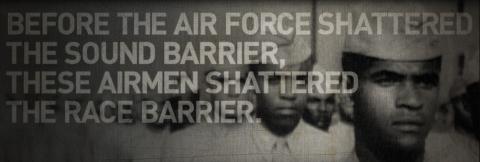African-Americans were not allowed to fly combat missions, for their country, until the "Tuskegee Airmen" changed history. Click on the image, of this headline, for a better view.
African-Americans who wanted to become military pilots were turned-down for most of the years between the two world wars. It wasn't just in the "Jim-Crow Era" South, where blacks faced discrimination. Even flight-training schools in the North did not readily admit black students.
Eugene Bullard - America's first black combat pilot who flew for France (in order to fly for the Allies during WWI) - could not serve as an American military pilot if he returned to the States. The color of his skin trumped his experience and ability (although the US Air Force appointed him a 2nd Lieutenant 33 years after his death).
As time passed, and the government kept denying blacks the right to fly for their country, African-Americans became civilian pilots instead. Charles Anderson, for example - America's first black transport pilot - had been a commercial flier since 1933. A man of few words, his favorite saying was:
Performance is the measure of merit.
By the time Eleanor Roosevelt took a ride in Anderson's Piper J-3 Cub, the Chief had already been at Tuskegee Institute for one year. He came to the school in 1940, at the request of Frederick Patterson (Tuskegee's president), to start Tuskegee's Civilian Pilot Training Program. (The U.S. government allowed six black colleges to join the Civilian Pilot Training Program in 1939.)
Soon the Chief had recruited four additional flight instructors: Milton P. Crenchaw (who is still alive), Charles Foxx (known as "Mr. Acrobatics"), Forrest Shelton (a white man who had helped to construct an airfield) and Richard Davis. If the federal government changed its policy - allowing black men to also train as combat pilots - Tuskegee was well-positioned to begin a new chapter in the school's history.
Ten days after Mrs. Roosevelt's visit, and her historic flight, President Roosevelt issued Executive Order - Number 8802 - authorizing full participation in U.S. defense programs, regardless of a person's race. This ... finally ... was the authority African-Americans needed to train as military pilots, and the Tuskegee Institute was ready to welcome them to Alabama.
White officers were sent to Tuskegee to supervise the training of pilots-in-the-making. One of those students was Captain Benjamin O. Davis (whose father was the first African-American general of the U.S. Army). One of those white officers was Noel Parrish, the commander of Tuskegee Army Air Field.
The black students greatly appreciated Parrish's fairness and encouragement.
Between 1941 and 1946, Charles Anderson was also part of the military-training team. The "Chief" worked with almost 1,000 students. It is for this reason that Anderson is called the "Father of Black Aviation."
Because he gave several interviews, which survive, we can "meet" the Chief today, even though he died (from cancer) in 1996.
With Anderson working hard as a Tuskegee instructor, the government created a new U.S. Army Air Corps Pursuit Squadron - the 99th. The first five cadets of the program - which was originally called the "Tuskegee Experiment" * but is also referred to as the "Tuskegee Experience" - graduated in 1942. They, and all those who followed - including everyone participating in flight training and maintenance - would be known as "Tuskegee Airmen."
Training to be a combat pilot - which takes place in a flight school - is one thing. Being a combat pilot - which takes place in a war zone - is something else.
The federal government did not authorize black combat trainees to become black combat pilots with experience until more time passed. A single Executive Order, issued by the President, could not erase a very long history of discrimination against African-Americans.
It wasn't until 1943 that the 99th flew its first combat sortie, in Europe. Let's follow the squadron's path, to see what happened.
* The "Tuskegee Experiment" for flight training and maintenance is not to be confused with the infamous "Tuskegee Experiment" for studying patients with syphilis. The former was public; the latter was hidden.
Forty years after the medical "experiment" about "Bad Blood" began, Jean Heller revealed its existence to the public. People were stunned to learn the federal government, via the U.S. Public Health Service, had authorized a program to study individuals who were ill without telling them (the truth about their conditions) or treating them (with anything that would help). Part of the "experiment" was to study the effects of untreated syphilis on the human body (including at autopsy examinations).


 Back
Back
 Next Chapter
Next Chapter

 Back
Back
 Next Chapter
Next Chapter


